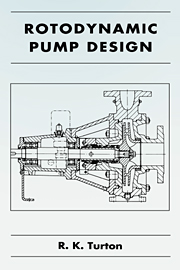Book contents
- Frontmatter
- Contents
- Preface
- Symbols
- 1 Fundamental principles
- 2 Cavitation in pumps
- 3 Centrifugal pump principles
- 4 Principles of axial and mixed flow pumps
- 5 Flow calculations in pumps and an introduction to computer aided techniques
- 6 Single stage centrifugal pump design
- 7 The design of axial and mixed flow pumps
- 8 Basic design principles of shafts, bearings and seals, and selection of drive
- 9 Pump design for difficult applications
- 10 An introduction to the next stage in the pump design process
- References
- Index
2 - Cavitation in pumps
Published online by Cambridge University Press: 29 September 2009
- Frontmatter
- Contents
- Preface
- Symbols
- 1 Fundamental principles
- 2 Cavitation in pumps
- 3 Centrifugal pump principles
- 4 Principles of axial and mixed flow pumps
- 5 Flow calculations in pumps and an introduction to computer aided techniques
- 6 Single stage centrifugal pump design
- 7 The design of axial and mixed flow pumps
- 8 Basic design principles of shafts, bearings and seals, and selection of drive
- 9 Pump design for difficult applications
- 10 An introduction to the next stage in the pump design process
- References
- Index
Summary
Introduction
Bubbles form in a flowing liquid in areas where the local pressure is close to the vapour pressure level. They form and collapse in a short time, measured in microseconds, and their life history gives rise to local transiently high pressures with flow instability. In pumps this results in noise, vibration and surface damage which can give rise to very considerable material loss.
The inception and collapse mechanisms are discussed briefly in this chapter, as are the conventional empirical rules used to ensure satisfactory pump behaviour. The chapter concludes with a discussion of the design rules to be followed in producing a good pump, and with a treatment of the techniques used to predict cavitation performance.
Bubble inception and collapse
In theory, cavities will form when the local liquid pressure level is equal to the vapour pressure under the local conditions. In practice bubbles form at higher pressure levels, due in part to the presence of very small bubbles or particles of detritus which act as triggers. A very exhaustive treatment of the process will be found in the monograph by Knapp et al. (1970), so a very brief summary will be given here.
Figure 2.1 is based on work done by Worster (1956) who used theoretical equations first published by Rayleigh (1917) to predict the life cycle of an existing small bubble as it grew and then collapsed.
- Type
- Chapter
- Information
- Rotodynamic Pump Design , pp. 15 - 28Publisher: Cambridge University PressPrint publication year: 1994



